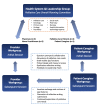Co-created Mobile Apps for Palliative Care Using Community-Partnered Participatory Research: Development and Usability Study
- PMID: 35737441
- PMCID: PMC9264134
- DOI: 10.2196/33849
Co-created Mobile Apps for Palliative Care Using Community-Partnered Participatory Research: Development and Usability Study
Abstract
Background: Open design formats for mobile apps help clinicians and stakeholders bring their needs to direct, co-creative solutions. Palliative care for patients with advanced cancers requires intensive monitoring and support and remains an area in high need for innovation.
Objective: This study aims to use community-partnered participatory research to co-design and pretest a mobile app that focuses on palliative care priorities of clinicians and patients with advanced cancer.
Methods: In-person and teleconference workshops were held with patient and family stakeholders, researchers, and clinicians in palliative care and oncology. Question prompts, written feedback, semistructured interviews, and facilitated group discussions identified the core palliative care needs. Using Chorus, a no-code app-building platform, a mobile app was co-designed with the stakeholders. A pretest with 11 patients was conducted, with semistructured interviews of clinician and patient users for feedback.
Results: Key themes identified from the focus groups included needs for patient advocacy and encouragement, access to vetted information, patient-clinician communication support, and symptom management. The initial prototype, My Wellness App, contained a weekly wellness journal to track patient-reported symptoms, goals, and medication use; information on self-management of symptoms; community resources; and patient and caregiver testimonial videos. Initial pretesting identified value in app-based communication for clinicians, patients, and caregivers, with suggestions for improving user interface, feedback and presentation of symptom reports, and gamification and staff coordinators to support patient app engagement.
Conclusions: The development of a mobile app using community-partnered participatory research is a low-technology and feasible intervention for palliative care. Iterative redesign and user interface expertise may improve implementation.
Keywords: CPPR; PRO; community-partnered participatory research; digital health; eHealth; mHealth; mobile apps; mobile health; mobile phone; oncology; palliative care; patient advocacy; patient-reported outcomes; quality of life; survivorship.
©Jafar Al-Mondhiry, Sarah D'Ambruoso, Christopher Pietras, Thomas Strouse, Dikla Benzeevi, Armen C Arevian, Kenneth B Wells. Originally published in JMIR Formative Research (https://formative.jmir.org), 23.06.2022.
Conflict of interest statement
Conflicts of Interest: AA reports owning stock, patents, and leadership within Chorus Innovations, Inc, where he serves as the chief executive officer.
Figures
Similar articles
-
A Mobile App to Improve Symptom Control and Information Exchange Among Specialists and Local Health Workers Treating Tanzanian Cancer Patients: Human-Centered Design Approach.JMIR Cancer. 2021 Mar 23;7(1):e24062. doi: 10.2196/24062. JMIR Cancer. 2021. PMID: 33755022 Free PMC article.
-
Mobile App Prototype in Older Adults for Postfracture Acute Pain Management: User-Centered Design Approach.JMIR Aging. 2022 Oct 17;5(4):e37772. doi: 10.2196/37772. JMIR Aging. 2022. PMID: 36251348 Free PMC article.
-
Co-Design in the Development of a Mobile Health App for the Management of Knee Osteoarthritis by Patients and Physicians: Qualitative Study.JMIR Mhealth Uhealth. 2020 Jul 10;8(7):e17893. doi: 10.2196/17893. JMIR Mhealth Uhealth. 2020. PMID: 32673245 Free PMC article.
-
Mobile Apps for Medication Management: Review and Analysis.JMIR Mhealth Uhealth. 2019 Sep 11;7(9):e13608. doi: 10.2196/13608. JMIR Mhealth Uhealth. 2019. PMID: 31512580 Free PMC article. Review.
-
Does a Smartphone App Help Patients with Cancer Take Oral Chemotherapy as Planned? [Internet].Washington (DC): Patient-Centered Outcomes Research Institute (PCORI); 2019 Apr. Washington (DC): Patient-Centered Outcomes Research Institute (PCORI); 2019 Apr. PMID: 37851845 Free Books & Documents. Review.
Cited by
-
Mapping Factors That Affect the Uptake of Digital Therapeutics Within Health Systems: Scoping Review.J Med Internet Res. 2023 Jul 25;25:e48000. doi: 10.2196/48000. J Med Internet Res. 2023. PMID: 37490322 Free PMC article.
-
Improving equity and wellness in cancer care with people of Latin American and African Descent: a study protocol.Front Oncol. 2025 Feb 26;15:1469037. doi: 10.3389/fonc.2025.1469037. eCollection 2025. Front Oncol. 2025. PMID: 40078189 Free PMC article.
-
A Bibliometric Analysis of Healthcare Intervention-Related Studies Reporting Patient and Public Involvement and Engagement.Healthcare (Basel). 2025 Feb 2;13(3):305. doi: 10.3390/healthcare13030305. Healthcare (Basel). 2025. PMID: 39942494 Free PMC article. Review.
References
-
- Tabi K, Randhawa AS, Choi F, Mithani Z, Albers F, Schnieder M, Nikoo M, Vigo D, Jang K, Demlova R, Krausz M. Mobile apps for medication management: review and analysis. JMIR Mhealth Uhealth. 2019 Sep 11;7(9):e13608. doi: 10.2196/13608. https://mhealth.jmir.org/2019/9/e13608/ v7i9e13608 - DOI - PMC - PubMed
-
- Smith TG, Troeschel AN, Castro KM, Arora NK, Stein K, Lipscomb J, Brawley OW, McCabe RM, Clauser SB, Ward E. Perceptions of patients with breast and colon cancer of the management of cancer-related pain, fatigue, and emotional distress in community oncology. J Clin Oncol. 2019 Jul 01;37(19):1666–76. doi: 10.1200/JCO.18.01579. http://europepmc.org/abstract/MED/31100037 - DOI - PMC - PubMed





